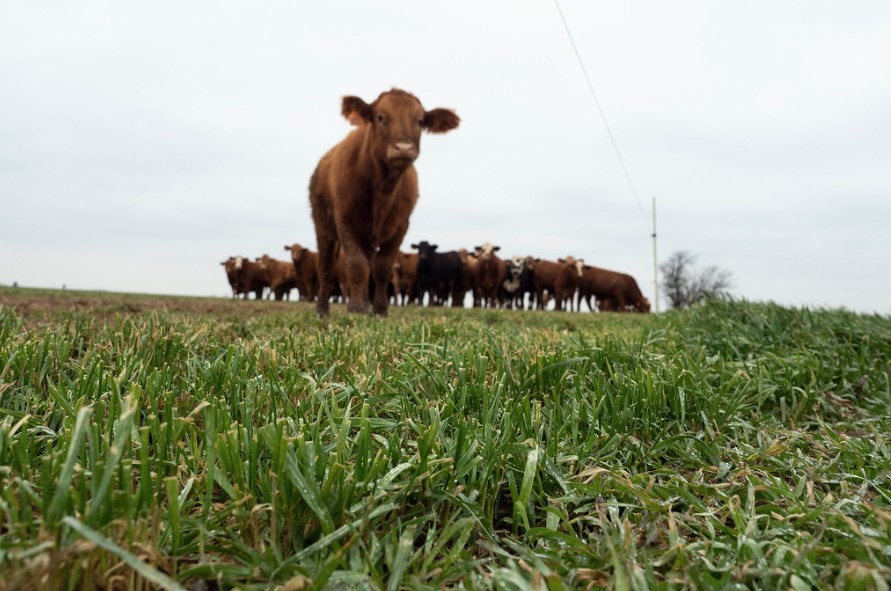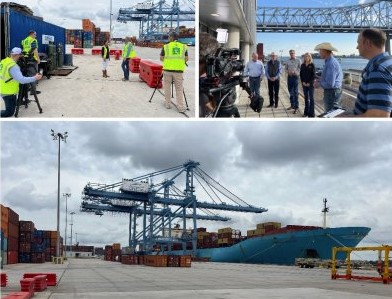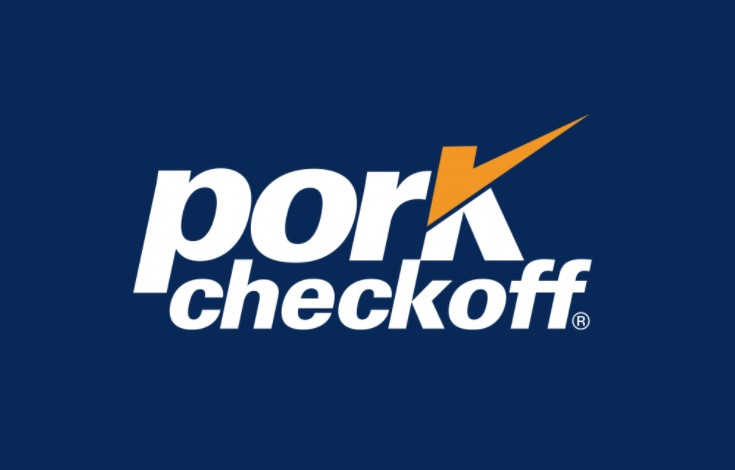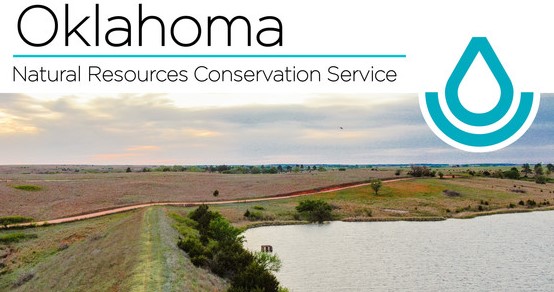Mon, 19 Sep 2022 13:48:35 CDT
The Oklahoma Wheat Commission just released the Oklahoma Wheat Brief for Summer/Fall of 2022. This edition highlights the best of recent news, progress and events in the Oklahoma wheat industry through an as…

Sep 19
Mon, 19 Sep 2022 13:48:35 CDT
The Oklahoma Wheat Commission just released the Oklahoma Wheat Brief for Summer/Fall of 2022. This edition highlights the best of recent news, progress and events in the Oklahoma wheat industry through an as…
Sep 19
Mon, 19 Sep 2022 13:31:51 CDT

Listen to today’s report with Justin Lewis, by clicking or tapping on the LISTEN bar
Sep 19
Mon, 19 Sep 2022 11:50:44 CDT
Majority of America’s farm households now rely on jobs and income outside of agriculture
U.S. farmers’ and ranchers’ increasing dependence on off-farm employment and income reveals the…
Sep 19
Mon, 19 Sep 2022 11:13:38 CDT

Drought conditions are still a major factor right now as producers strategize when and how much wheat to sow over the next few weeks.
A current lack of subsoil moisture limits wheat’s potential to sprout and germinate, and some farmers may decide to “dust in” wheat. The Oklahoma State University Extension fact sheet on planting dual purpose wheat explains dusting it in as a technique that plants seeds in shallow soil (less than 1 inch) in the hopes of rainfall later this fall.
Greg Hartman, agriculture and 4-H educator for Oklahoma State University Extension in Washita and Beckham counties, said in addition to the heat and dry climate, grasshoppers and armyworms are still present and could damage tender wheat seedlings. However, ranchers in desperate need of fall grazing pastures may already have some wheat in the ground.
“Everybody is getting anxious (to plant) as the days get shorter,” he said. “A lot of people think Sept. 15 is the optimal time to plant according to old timers, but it’s been proven by OSU researchers that whether you plant on Aug. 20 or Sept. 15, it’s all about on the same pace come Nov. 15.”
Only 15-20% of the wheat planted in Hartman’s area of western Oklahoma will be harvested for grain. The rest is used as a forage source for cattle. Hartman encourages producers to ask their county OSU Extension office for assistance in conducting a soil test before planting. Residual nitrogen and other minerals are common this year in soil results because of drought conditions.
Josh Bushong, OSU Extension area agronomist for the west district, explained on a recent episode of the Extension Experience podcast that nitrogen and residue management affect forage yields in wheat pastures.
“If you have a lot of residue from the previous wheat crop or failed summer crop, you’re going to have a harder time getting pasture established,” he said. “While the crop residue has benefits such as soil water retention, it can make it more difficult to get proper seed to soil contact for good seed germination. Focus on fallowed or tilled fields for fall pasture, and for those other fields (with residual nitrogen tied up in the crop residue), delay planting until October and target just a grain crop instead of forage and grain.”
Bushong said producers planting wheat for fall pasture should make available at least 60 pounds of nitrogen per acre (between soil residual and applied fertilizer) to ensure at least a ton of forage production. For a grain-only crop, he recommends no more than 40 pounds.
“If you’re turning cattle out to fall pasture, the biggest thing is early establishment,” Bushong said. “The quicker we can get that plant up and growing, the more biomass we’re going to produce in the fall.”
For farmers sowing dual-purpose wheat, 90 to 120 pounds of seed per acre is the normal rate. Bushong said producers should calculate their seeding rates based on forage needs and expected stocking rates of a pasture.
The rising costs of fuel, fertilizer and other materials are also a variable this fall. Kim Anderson, OSU Extension grain marketing specialist, said wheat prices have leveled out and show little volatility right now, but international pressures, such as the war in Ukraine and the building conflict between China and Taiwan, could quickly move market prices in either direction.
“We could see $6 bushel per acre wheat or $14 bushel per acre wheat (next year), but the market is telling us right now that we’re going to see $8 per acre,” Anderson said.
OSU Extension uses research-based information to help all Oklahomans solve local issues and concerns, promote leadership and manage resources wisely throughout the state’s 77 counties. Most information is available at little to no cost.
Sep 19
Mon, 19 Sep 2022 10:39:09 CDT

Later this month, viewers of Cattlemen to Cattlemen on RFD-TV will get a firsthand look at the value of corn and beef exports at the Port of New Orleans. In 2021, beef and port exports accounted for 537 million bushels of corn usage.
“The U.S. is the world’s leading exporter of corn and when you pair that with the success of exports of the beef industry, it is an important demand driver for corn farmers,” said National Corn Growers Association (NCGA) incoming President and Minnesota farmer Tom Haag. “Being at the Port of New Orleans for this episode was a great backdrop because of the amount of agricultural goods and product that goes out of this port.”
Panel participants include Tom Haag, incoming NCGA President and Minnesota farmer; National Cattlemen’s Beef Association (NCBA) President and Minnesota farmer Don Schiefelbein; NCGA Market Development Action Team Chair and Colorado corn and beef producer Troy Schneider; and Kyla Hamilton, a Texas corn and beef producer who also serves on MDAT. Special interview segments are also a part of the show this year, with Janine Mansour who is head of business development for the Port of New Orleans and Dean Myers, Chair-Elect of the U.S. Meat Export Federation (USMEF).
NCGA’s Market Development Action Team (MDAT) funded this initiative. The episode will air on Tuesday, September 27th on RFD-TV at 8:30 PM ET. You can watch last year’s episode here.
NCBA’s Cattlemen to Cattlemen is a television show for cattlemen created by cattlemen. Colorado cattle producer Kevin Ochsner hosts the show..
Sep 19
Mon, 19 Sep 2022 10:35:47 CDT

Pork producers are invited to register and tune in as experts share insights generated from menu modeling research funded by Pork Checkoff dollars.
Webinar: Insights from Food Modeling Research — Putting the Thrifty Food Plan into Practice
When: Sept. 22 at 11 a.m. CT
Can’t make it? Register anyway, and we’ll share a recording afterwards.
To register, click here.
With food inflation, hunger and nutrition insecurity at all-time highs, low-income families are challenged to keep nutritious meals on home menus while staying within their budgets.
In August of 2021, the USDA announced a 21% increase in benefits under the Supplemental Nutrition Assistance Program (SNAP). The extra benefits are based on USDA’s review of the Thrifty Food Plan, which estimates the cost of a healthy diet to feed a family of four.
This means more families will have better access to foods that satisfy their nutritional needs. NPB is working to ensure protein-packed pork is at the top of their grocery lists.
Pork has a huge role to play as a high-quality, affordable and nutrient-dense protein that satisfies many taste and cultural preferences.
NPB has assembled experts with roles in academia, government-adjacent organizations, and non-profits in the food policy sector to update dietitians and others in health professions.
They’ll talk about what it takes to put an optimized, affordable and nutrient-dense eating plan into practice and what this increase in benefits means for their patients and clients.
Sep 19
Mon, 19 Sep 2022 10:34:04 CDT

Water and sewage projects in Oklahoma City, including relocation of a water transmission main that supplies drinking water near Tinker Air Force Base, are among recommendations to receive American Rescue Plan Act (ARPA) funds by the Oklahoma House and Senate Joint Committee on Pandemic Relief Funding. The committee proposes spending $35 million for partnerships with municipalities, cities or tribes to coordinate on the projects.
The projects, along with others, will be considered when the Legislature reconvenes it’s special session to appropriate ARPA funds.
“This necessary infrastructure investment is important to the multitude of people that call Oklahoma City and its surrounding communities home,” said Rep. Rhonda Baker, R-Yukon. “It particularly impacts those living near the largest Air Force base in our state, which is a key economic driver and employs thousands of Oklahomans.”
The portion of the project near Tinker became necessary after the city of Oklahoma City closed a two-mile section of Douglas Boulevard for base security. A portion of the water main is now inside the base security zone and must be rerouted. In the event of a break, security levels at the base would delay emergency response time, impacting public health, safety and water service to area residents.
Baker is co-chair of the Economic Development and Workforce Working Group that recommended the project to the joint committee, of which she also is a member.
Rep. Ryan Martinez, R-Edmond, is vice chair of the House Appropriations & Budget Committee, a member of the joint committee and a lawmaker whose district includes parts of the Oklahoma City metropolitan area. He said these water and sewage projects are necessary to protect public health and safety in the area.
“The Oklahoma City metropolitan area is the most populated area in our state,” Martinez said. “In terms of total land area, we’re considered the second largest capital city in the world. It only makes sense that we make use of this funding to strengthen our infrastructure for those who call this area home and those who visit or hope to relocate here, including members of our military.”
The water and sewage projects are among the proposals to be considered when the Legislature reconvenes the Second Extraordinary Session of the 58th Oklahoma Legislature, which was called for the purpose of evaluating ARPA projects advanced by the joint committee.
The overall goal is to determine projects that will result in the greatest benefit to the state. The committee considered public input and took the recommendation of working groups to determine its final project list.
The new proposals are in addition to projects passed by the Legislature during special session held in June.
Sep 19
Mon, 19 Sep 2022 10:03:35 CDT
Senior Farm and Ranch Broadcaster, Ron Hays, is talking about cow herd liquidation with commentary from OSU’s Extension Livestock Market Economist, Dr. Derrell Peel and Bob Rodenberger with Stockman O…
Sep 19
Mon, 19 Sep 2022 09:40:02 CDT
Weekly, Dr. Derrell Peel, Oklahoma State University Extension Livestock Marketing Specialist, offers his economic analysis of the beef cattle industry. This analysis is a part of the weekly series known as t…
Sep 19
Mon, 19 Sep 2022 09:22:03 CDT

Hello Oklahoma! I am Brandon Bishop, the Acting State Conservationist for Oklahoma. As some of you are aware, Gary O’Neill retired and I am honored and humbled to have this opportunity to serve in this role. I am originally from Arizona but have called Oklahoma home for about eight years now.
NRCS is adopting a new approach, the Great Plains Grassland Initiative (GPGI) to address woody plant encroachment. This threat of plant encroachment puts pressure on working rangelands by decreasing livestock production and increasing wildfire risk as well as harming grassland biodiversity and increasing threat to animal species living in this biome. The initiative is part of the NRCS Working Lands for Wildlife (WLFW) framework calling to conserve the last remaining iconic grassland regions in the Great Plains.
Producers in targeted rangelands are eligible to receive Environmental Quality Incentives Program (EQIP) funding related to addressing woody plant encroachment. Please contact your local NRCS office for assistance on this initiative and others that assist on your operation.
– Brandon Bishop, Acting State Conservationist